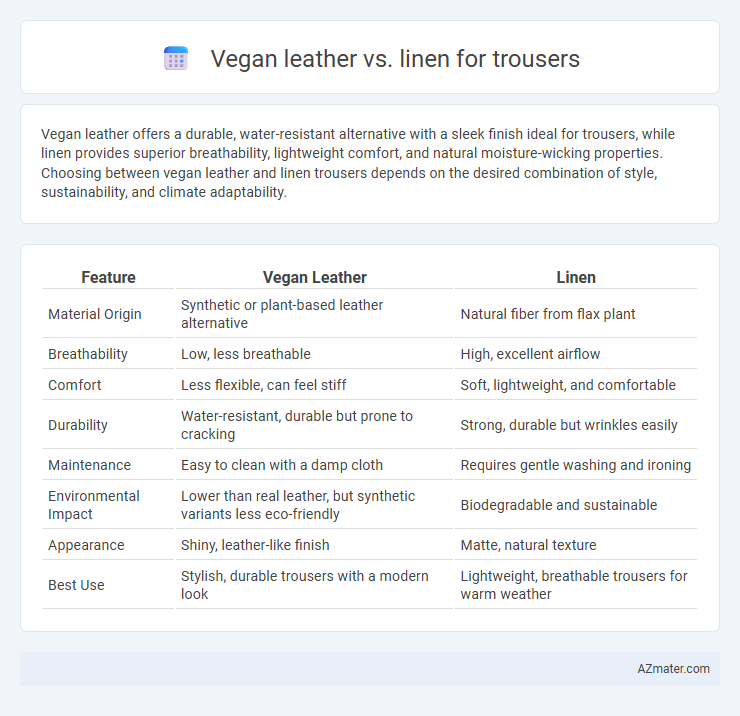Vegan leather offers a durable, water-resistant alternative with a sleek finish ideal for trousers, while linen provides superior breathability, lightweight comfort, and natural moisture-wicking properties. Choosing between vegan leather and linen trousers depends on the desired combination of style, sustainability, and climate adaptability.
Table of Comparison
| Feature | Vegan Leather | Linen |
|---|---|---|
| Material Origin | Synthetic or plant-based leather alternative | Natural fiber from flax plant |
| Breathability | Low, less breathable | High, excellent airflow |
| Comfort | Less flexible, can feel stiff | Soft, lightweight, and comfortable |
| Durability | Water-resistant, durable but prone to cracking | Strong, durable but wrinkles easily |
| Maintenance | Easy to clean with a damp cloth | Requires gentle washing and ironing |
| Environmental Impact | Lower than real leather, but synthetic variants less eco-friendly | Biodegradable and sustainable |
| Appearance | Shiny, leather-like finish | Matte, natural texture |
| Best Use | Stylish, durable trousers with a modern look | Lightweight, breathable trousers for warm weather |
Introduction to Vegan Leather and Linen Trousers
Vegan leather trousers offer a cruelty-free, sustainable alternative to traditional leather, made from materials like polyurethane or cork that provide durability and a sleek finish. Linen trousers, crafted from flax fibers, are highly breathable and lightweight, ideal for warm weather and ensuring comfort. Both materials cater to ethical fashion but differ significantly in texture, maintenance, and environmental impact, influencing consumer choice.
Material Origins: Vegan Leather vs Linen
Vegan leather is a synthetic material derived from polyurethane or plant-based sources such as cork and pineapple leaves, designed to mimic the appearance of traditional leather without animal products. Linen is a natural fiber made from the flax plant, known for its breathability, durability, and eco-friendly cultivation process. While vegan leather offers water resistance and a sleek finish, linen provides superior moisture-wicking properties and sustainable growth with minimal environmental impact.
Sustainability and Environmental Impact
Vegan leather, often made from polyurethane or plant-based materials like pineapple leaves, offers a cruelty-free alternative but can vary widely in environmental impact due to synthetic production processes and limited biodegradability. Linen, derived from flax plants, is highly sustainable with low water and pesticide requirements, natural biodegradability, and carbon sequestration benefits during cultivation. Choosing linen trousers typically results in a lower environmental footprint compared to most vegan leather options, emphasizing renewable resources and reduced chemical inputs.
Comfort and Breathability Comparison
Vegan leather trousers offer a sleek, stylish appearance but tend to lack breathability, often causing discomfort in warm weather due to poor moisture-wicking properties. In contrast, linen trousers excel in comfort and breathability with their natural fiber composition, allowing superior air circulation and moisture absorption, making them ideal for hot climates. The lightweight and porous structure of linen ensures enhanced ventilation, reducing sweat buildup compared to the synthetic, less permeable surface of vegan leather.
Durability and Longevity
Vegan leather offers high durability due to its synthetic composition, resisting wear and stains better than many natural fabrics. Linen trousers, while breathable and comfortable, tend to wear out faster as the natural fibers are prone to fraying and creasing over time. For longevity, vegan leather generally outperforms linen by maintaining its structure and appearance through frequent use and multiple washes.
Style and Aesthetic Appeal
Vegan leather trousers offer a sleek, modern look with a subtle sheen that creates a bold, edgy style, perfect for fashion-forward individuals seeking a polished appearance. Linen trousers provide a natural, breathable texture with a matte finish, delivering a relaxed yet sophisticated aesthetic ideal for warm-weather wear and casual elegance. Both materials cater to distinct style preferences, with vegan leather emphasizing contemporary urban chic and linen highlighting timeless, effortless comfort.
Maintenance and Care Requirements
Vegan leather trousers require gentle cleaning with a damp cloth and occasional conditioning to prevent cracking, avoiding harsh chemicals and direct heat to maintain their appearance. Linen trousers demand frequent washing due to their natural fibers, with a preference for cold water and mild detergents to prevent shrinkage and maintain fabric breathability. Both materials benefit from air drying and minimal ironing, but linen's higher moisture retention necessitates more careful handling to avoid wrinkles and prolong garment life.
Cost Analysis: Vegan Leather vs Linen
Vegan leather trousers typically incur higher production costs due to synthetic material processing and durability treatments, resulting in retail prices 20-40% above linen counterparts. Linen trousers benefit from lower raw material expenses and simpler manufacturing, making them more cost-effective and accessible for budget-conscious consumers. Long-term maintenance costs also favor linen, as vegan leather requires specialized cleaning and may degrade faster with improper care.
Ethical Considerations
Vegan leather offers an animal-friendly alternative by eliminating the use of animal hides, reducing harm to wildlife and supporting cruelty-free fashion. Linen, derived from flax plants, boasts a low environmental impact due to its biodegradability and minimal pesticide requirements, making it highly sustainable. Choosing between vegan leather and linen for trousers involves weighing animal welfare against ecological footprint, with vegan leather favoring ethical animal treatment and linen emphasizing renewable resource efficiency.
Conclusion: Choosing the Right Material for Trousers
Vegan leather trousers offer a sleek, water-resistant option with a modern, durable finish ideal for fashion-forward wearers seeking cruelty-free alternatives. Linen trousers provide superior breathability, lightweight comfort, and natural moisture-wicking properties, making them perfect for warm weather and casual or professional settings. Selecting the right material depends on prioritizing style and weather resistance with vegan leather or comfort and breathability with linen for trousers.

Infographic: Vegan leather vs Linen for Trousers
 azmater.com
azmater.com